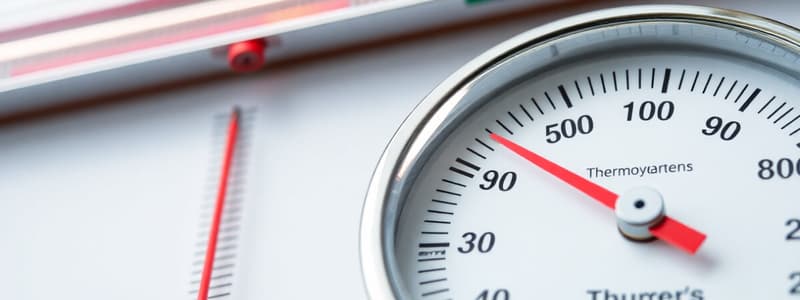Podcast
Questions and Answers
What is the definition of heat?
What is the definition of heat?
- The transfer of energy due to a temperature difference (correct)
- A measure of the average kinetic energy of the molecules in a system
- The ability of a substance to conduct heat
- The amount of energy contained within a system
What is a thermometer used for?
What is a thermometer used for?
- Measuring the density of a substance
- Measuring the mass of a substance
- Measuring the volume of a substance
- Measuring the temperature of a substance (correct)
What is the principle behind the operation of a thermometer?
What is the principle behind the operation of a thermometer?
- The change in mass of a substance with temperature
- The change in density of a substance with temperature
- The change in color of a substance with temperature
- The change in volume of a substance with temperature (correct)
Which of the following best describes the concept of temperature?
Which of the following best describes the concept of temperature?
Which of the following is NOT a common phrase that uses the word ‘heat’ incorrectly?
Which of the following is NOT a common phrase that uses the word ‘heat’ incorrectly?
Which type of thermometer utilizes the change in electrical resistance with temperature?
Which type of thermometer utilizes the change in electrical resistance with temperature?
What is the upper fixed point on the Celsius scale?
What is the upper fixed point on the Celsius scale?
Which of the following is NOT a thermometric substance used in thermometers?
Which of the following is NOT a thermometric substance used in thermometers?
What is the physical property measured in a constant-volume gas thermometer?
What is the physical property measured in a constant-volume gas thermometer?
Which of the following thermometers is suitable for measuring very high temperatures, up to 1500 ℃?
Which of the following thermometers is suitable for measuring very high temperatures, up to 1500 ℃?
What is the fundamental interval of a temperature scale?
What is the fundamental interval of a temperature scale?
Which temperature scale has its zero point defined as absolute zero, the theoretical temperature at which all molecular motion ceases?
Which temperature scale has its zero point defined as absolute zero, the theoretical temperature at which all molecular motion ceases?
In the equation 𝜃 = (𝑋𝜃 − 𝑋0) / (𝑋100 − 𝑋0) * 100, what does 𝑋𝜃 represent?
In the equation 𝜃 = (𝑋𝜃 − 𝑋0) / (𝑋100 − 𝑋0) * 100, what does 𝑋𝜃 represent?
What is the main reason why it is advisable to sterilize a clinical thermometer in boiling water?
What is the main reason why it is advisable to sterilize a clinical thermometer in boiling water?
Why is a thick stem used in some clinical thermometers?
Why is a thick stem used in some clinical thermometers?
What is the principle behind a constant-volume gas thermometer?
What is the principle behind a constant-volume gas thermometer?
What property is used to measure temperature in a resistance thermometer?
What property is used to measure temperature in a resistance thermometer?
What is the thermoelectric effect?
What is the thermoelectric effect?
Which of these is NOT a type of thermometer discussed in the content?
Which of these is NOT a type of thermometer discussed in the content?
Based on the provided information, what is the temperature range of a clinical thermometer?
Based on the provided information, what is the temperature range of a clinical thermometer?
What is the primary reason why thermometers use bulbs at the bottom instead of just a simple column of liquid?
What is the primary reason why thermometers use bulbs at the bottom instead of just a simple column of liquid?
What is the normal temperature of a human body in Celsius?
What is the normal temperature of a human body in Celsius?
What does the constriction near the bulb in a clinical thermometer allow?
What does the constriction near the bulb in a clinical thermometer allow?
What is a key difference between mercury and alcohol in a thermometer?
What is a key difference between mercury and alcohol in a thermometer?
What is the temperature range of a typical clinical thermometer?
What is the temperature range of a typical clinical thermometer?
Which of the following is NOT a characteristic of a liquid-in-glass thermometer?
Which of the following is NOT a characteristic of a liquid-in-glass thermometer?
Why is the bore of a clinical thermometer narrow?
Why is the bore of a clinical thermometer narrow?
What is the boiling point of mercury?
What is the boiling point of mercury?
Why is it important to shake a clinical thermometer before using it?
Why is it important to shake a clinical thermometer before using it?
Flashcards
Heat
Heat
The transfer of energy due to temperature difference.
Temperature
Temperature
A measure of how hot or cold an object is.
Thermal Equilibrium
Thermal Equilibrium
Condition where two objects have the same temperature.
Thermometer
Thermometer
Signup and view all the flashcards
Temperature Scales
Temperature Scales
Signup and view all the flashcards
Liquid-in-glass Thermometer
Liquid-in-glass Thermometer
Signup and view all the flashcards
Constant-volume Gas Thermometer
Constant-volume Gas Thermometer
Signup and view all the flashcards
Platinum Resistance Thermometer
Platinum Resistance Thermometer
Signup and view all the flashcards
Thermocouple
Thermocouple
Signup and view all the flashcards
Fixed Points
Fixed Points
Signup and view all the flashcards
Fundamental Interval
Fundamental Interval
Signup and view all the flashcards
Celsius Scale
Celsius Scale
Signup and view all the flashcards
Kelvin Scale
Kelvin Scale
Signup and view all the flashcards
Clinical Thermometer
Clinical Thermometer
Signup and view all the flashcards
Sterilizing Thermometers
Sterilizing Thermometers
Signup and view all the flashcards
Pressure Equation
Pressure Equation
Signup and view all the flashcards
Resistance Thermometer
Resistance Thermometer
Signup and view all the flashcards
Thermocouple Thermometer
Thermocouple Thermometer
Signup and view all the flashcards
Thermoelectric Effect
Thermoelectric Effect
Signup and view all the flashcards
Mercury Expansion
Mercury Expansion
Signup and view all the flashcards
Celsius to Fahrenheit formula
Celsius to Fahrenheit formula
Signup and view all the flashcards
Celsius to Kelvin formula
Celsius to Kelvin formula
Signup and view all the flashcards
Fahrenheit to Celsius formula
Fahrenheit to Celsius formula
Signup and view all the flashcards
Kelvin to Celsius formula
Kelvin to Celsius formula
Signup and view all the flashcards
Mercury vs. Alcohol thermometer
Mercury vs. Alcohol thermometer
Signup and view all the flashcards
Kink in thermometer
Kink in thermometer
Signup and view all the flashcards
Study Notes
Introduction to Physics Lecture Notes (Pre-Med/Pre-Pharmacy)
- This is a physics lecture note program for premedical and pre-pharmacy students at the University of Sierra Leone.
- The notes cover fundamental concepts of temperature and heat, with focus on different temperature scales.
- The lecture includes discussion, examples and practice problems in the scope of measuring temperature.
What is Heat?
- Heat is defined as the transfer of energy across the boundary of a system due to a temperature difference.
- Heat, internal energy, and temperature are distinct quantities.
What is Temperature?
- Temperature is a property that determines whether an object is in thermal equilibrium with other objects.
- Two objects in thermal equilibrium are at the same temperature.
- Temperature's concept originates from common concepts like "hot" and "cold," refined through qualitative to quantitative measures.
Thermometers
- Thermometers are devices for measuring temperature.
- They function based on the principle that a physical property of a system changes with temperature.
- Different types of thermometers exist, utilizing diverse physical properties
- Liquid-in-glass: utilizes mercury or alcohol expansion.
- Constant-volume gas: measures gas pressure at a constant volume.
- Resistance thermometer: tracks changes in electrical resistance of a platinum wire.
- Thermocouple: measures temperature using the thermoelectric effect in two dissimilar metal junctions.
Fixed Points
- Fixed points are established standards of temperature on any specific scale. These are used to calibrate and compare different scales.
- Lower fixed point : Equilibrium point between ice and air-saturated water at standard atmospheric pressure, 0°C.
- Upper fixed point : Equilibrium point between vapor and boiling water at standard atmospheric pressure, 100°C.
- Multiple fixed points can be used for higher precision. (not further detailed)
Temperature Scales
-
Celsius: Based on the ice and steam points.
-
Fahrenheit: Also establishes two fixed points.
-
Kelvin: Absolute zero as its lowest point, related to both Celsius and Fahrenheit scales.
-
Formulas for converting between temperature scales are provided:
- Celsius to Fahrenheit: F = (9/5)C + 32
- Fahrenheit to Celsius: C = (5/9)(F-32)
- Celsius to Kelvin: K = C + 273
Clinical Thermometers
- Clinical thermometers measure body temperature primarily using liquid-in-glass.
- These thermometers typically have a narrow range of operation (typically 35°C to 43°C).
- Design features like a constriction in the tube prevent mercury from flowing back into the reservoir when the thermometer is removed from the body.
Constant-volume Gas Thermometer
- A constant-volume gas thermometer keeps the volume of a fixed mass of gas constant, measuring temperature through changes in pressure.
- The gas's pressure change is directly proportional to temperature change.
Resistance Thermometer
- The electrical resistance of a pure platinum wire increases with temperature.
- Resistance thermometers' precision makes them suitable for high-accuracy measurements.
Thermocouple Thermometer
- Used for high temperatures, a thermocouple uses the temperature dependence of the voltage produced at the junction of two different metals to measure temperature. The voltage change at the constant cold junction is linearly proportional to temperature.
Practice Problems (examples)
- Several practice problems are included in the notes involving temperature conversions, interpreting thermometer readings, and calculation of temperature changes, designed to illustrate practical applications.
Studying That Suits You
Use AI to generate personalized quizzes and flashcards to suit your learning preferences.




